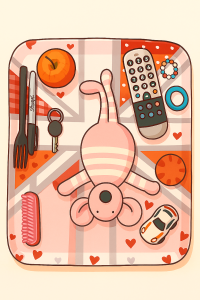
Kim’s Game is a classic memory activity that works brilliantly for reviewing there is / there are (and their past forms) while introducing useful household vocabulary. It’s simple to set up and always gets students talking.
What You’ll Need
- A tray or large plate
- A tea towel or cloth to cover it
- Around 15 small, everyday household objects (some in multiples)
Example items:
a battery, a tea bag, a fork, two teaspoons, a light bulb, a rubber band, a coaster, an eraser, a lighter, a few coins, a pencil sharpener…
Make sure everything fits neatly on the tray and can be covered fully.
How to Play Kim’s Game
1. Introduce the Theme
Start by teaching or reviewing the word remember and the noun memory. Ask a few light questions:
- Do you have a good memory?
- How many phone numbers can you remember?
Tell them you’re going to test their memory with a fun game.
2. The Viewing Phase
Place the tray on a table with the items hidden under the cloth. Have students gather around. Explain that they’ll have 30 seconds to memorise as many items as they can.
Uncover the tray. After 30 seconds, cover it again and send students back to their seats.
3. Individual Recall
Give them 2–3 minutes to write down as many objects as they can remember. If they don’t know the English word, they can draw it or write it in their native language.
Who remembered the most?
4. Pair Work
Now tell them there were 15 objects. Ask students to work in pairs to combine their lists and see if they can figure out any missing items — and how many they know the English for.
5. Group Feedback Using “There Is / There Are”
Go around the class and ask students to name one object each using there is or there are. For example:
There is a battery.
There are two spoons.
Write each object on the board as it’s mentioned. Remove items from the tray one by one as students identify them.
